Google Purchasing Actions: Tips on how to Improve Product Visibility for Free
Did you know that Google Shopping deals are free for most merchants?
Google has also cut commissions for its "Buy from Google" program. This means that almost any retailer can sign up for Google Shopping Actions and link their products without paying the 12% commission that Google previously collected on every sale.
Retailers and advertisers have a unique opportunity to promote their products in an incredible way. Almost half of the users turn to Google to find or discover new products. This means that even small businesses can introduce themselves to millions of new potential customers with just a few clicks.
What are Google Shopping Promotions?
Google Shopping Actions works with multiple retailers to create a shopping experience that competes directly with Amazon. With this program, retailers today can upload products that appear in organic search on Google platforms. In return, buyers can find, compare, and buy products without ever leaving Google.
The side facing the user is called "Google Shopping". When a user searches for a product, he or she places relevant items on the shopping tab of their results page, as well as a number of options to purchase. Customers get access to a universal shopping cart, shareable lists and an instant checkout with saved payment information.
So if you burn a pan while you're cooking, you can use Google Home to buy a new one, add it to your cart to buy later, or browse, compare, and buy new pans on your phone right away.
Just like Amazon, users who use Google Shopping to make purchases will see personalized recommendations across platforms.
All of this makes for a seamless shopping experience that can increase conversions and reduce the number of abandoned carts.
Note: Google Shopping promotions are not the same as Google Shopping ads. Retailers pay to have their results displayed as Google Shopping Ads, while organic shopping promotions are free. The organic search element sets it apart from Google Shopping Ads, where retailers pay for placement.
What does the ordering process look like on Google Shopping Actions?
For example, let's return to the burned pan to go through the customer's buying process. After entering "Skillet" and viewing a results page, click on the "Shopping" tab at the top of the first SERP. You will be given a list of pan options as well as filters on the left to narrow your search.
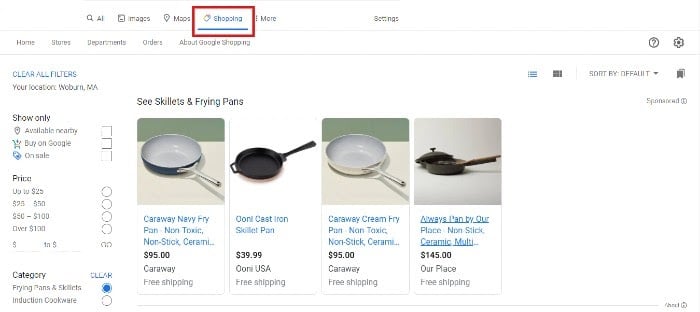
If you select "Buy from Google" you will only get options that you can buy directly from Google. The small shopping cart symbol in the top left corner of each result shows you which belong to the "Buy from Google" program:
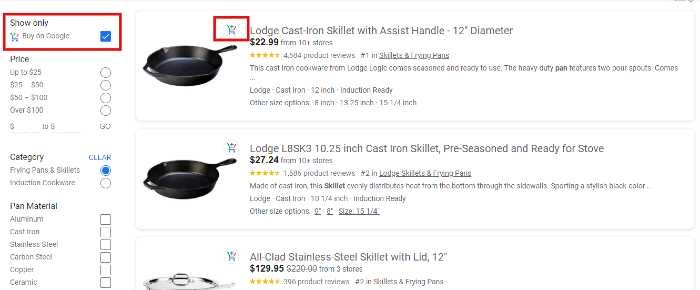
Let's say you've looked at this lodge pan that Target ships with. You'll see product descriptions and ratings, as well as the average price of similar items, to make it easier to compare.

If you want to purchase this, you can add the item to your cart or buy it immediately.
You never had to go to the target website, and you never had to search through multiple websites to compare them.
Get started with Google Shopping Actions
The Google Merchant Center and Google Shopping Actions are very flexible. You can connect third-party platforms already in use like Shopify and SureDone and even link your Amazon feed to reduce labor redundancy.
To set up shopping promotions, you must first sign up for a free account in Google's Merchant Center. It's basically your Google Shopping dashboard. Then, as part of the Merchant Center sign-up process, you select shopping deals.
Once you're signed in, you'll be asked to do the following:
- List products
- Add branding
- Select Tax and Shipping Settings
- Select the return settings
- Set up user roles
- Provide customer service contact information
- Decide whether customers will be invited to sign up for a newsletter at the checkout
- Include promotional information
The latter is optional, but Google recommends running promotions to attract more customers.
To use Google Shopping Actions, you need to implement the Orders API. This way you can use the Google Merchant Center to manage your orders.
Of course, one of the really attractive features of Google Shopping Actions is that you don't have to manage your orders yourself. Google can handle shipping and returns, and provide customer service if you choose. It's all up to you.
As soon as a user purchases something through Google Shopping, the order appears as "in progress" in your API for about 30 minutes. In this half-hour window, customers can cancel their order in whole or in part if necessary. Google recommends that you do not send anything until the status changes to Pending Shipment.
Things to Look For in Google Shopping Actions
The first thing to note is that free Google shopping lists are for organic search only. If you want to get your products on certain SERPs, you need to pay through Google's Shopping Ads program.
If you already run Google Ads, you should set up the same products in Google Shopping Actions. This way you get double the exposure for the same price.
Additionally, Google Shopping Actions is currently only available in the US and France. To sign up, you must be a legally registered company in one of these countries and be able to accept payments, make deliveries and process returns in these locations.
The Google Buy Promotions guidelines also include the following:
- Your inventory cannot contain restricted products and services. A list is available from Google Support.
- You need a valid ID from the country in which your company is registered.
- You must meet all Google standards for returns and customer support.
List your products on Google Shopping Actions
In order to list your products on Google Shopping, you need to set up a product feed. For your product feed, Google needs the following information:
- A product identification number (ID)
- Product title such as cast iron pan (title)
- A product description (description)
- A link to your product page (link)
- A link to your picture (image_link)
- Product availability (availability)
- Product price (price)
- Google product category such as kitchenware or cooking (google_product_category)
- Product brand name (brand)
- Global Trade Item Number (GTIN)
Google can crawl your website if you've already set up this information, or you can fetch it from your servers. If you haven't set up this information, you can create a Google Sheet or Excel spreadsheet that you can upload to your merchant account. Use the names in brackets to identify your categories.
A very simple product data table would look something like this:
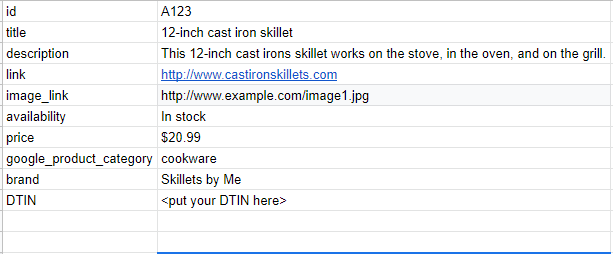
This information now applies to your primary feed. You can also set up additional feeds that cover sales, limited edition products, or special offers.
Optimize your Google shopping lists
As with your website, you want to make sure that your listings are optimized for organic search.
First, make sure that all of your information is correct, from your description to your price. If necessary, use geotagging to ensure that they appear in local searches.
Check that the title, description, and images are also optimized.
Product title
Use strong keywords that reflect user searches in your title. Do keyword research to see what users are looking for when they search for similar products. You can use a keyword tool or just view the "People Also Ask" and "Searches Related" sections of a Google results page.
Remember, using strong keywords in your product title will not only help users find you, it will also help Google place your products on the right results pages. Google searches both product titles and descriptions for detailed keywords to rank products.
So try something more detailed instead of using "pan" as the title alone, e.g. B. "12 Inch Cast Iron Pan".
Product description
Make your product descriptions detailed and pragmatic. Phrases like "amazing pan" won't get you organic search points. "Our 12-inch cast iron pan is seasoned with olive oil and holds the heat well," tells both the user and Google exactly what your product is.
Remember to keep it short and sweet. Only 70 words are shown on Google's product pages.
Product images
According to a Weebly survey, 75% of online shoppers said that product images have a huge impact on their decision-making process. That means your images should make your products as appealing as possible.
The images should be clear, well-lit, and professional. And your products should be in front and in the middle.
Select multiple images that match your product scale, view it from different angles, and show it in use so users can get an idea of how it works for them.
For the cast iron pan, Lodge shows her product, which is served with chicken and sizzles on a grill with vegetables.
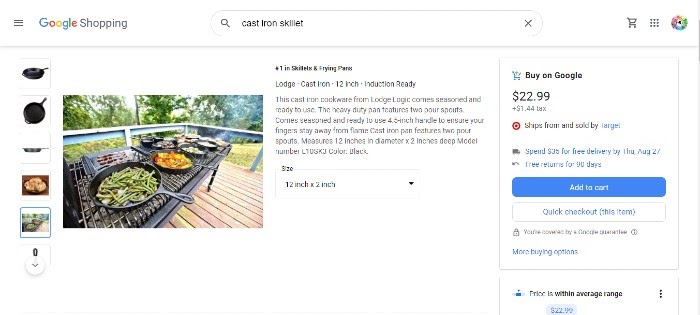
Monitor your product lists
Finally, keep an eye on your product lists. Compare them to similar listings that work well to see how you can improve your own. Look for increasing or decreasing visibility and clicks to see if you can match them to search trends.
Stay up to date with the changes in the Google algorithm. Changing the way Google places organic search content can affect your listings.
What will change with Google Shopping promotions?
Aside from free offers and no commissions, Google is making a few other changes to the Google Shopping experience:
- Starting with PayPal, Google now enables merchants' payment accounts to be linked directly to the Google Merchant Center.
- Merchants can handle customer service directly, but they still have Google customer service to keep them safe.
- With Google, retailers can process their returns themselves or have them managed by Google.
- The Google Merchant Center is compatible with your Amazon feed.
Google Shopping Actions against Amazon
Amazon is still the leader in online shopping. But Google is starting to give the e-commerce giant a chance, especially now that the offerings are free. Google has a few other advantages over Amazon.
In contrast to Amazon, Google initially offers customers more than one purchase option for products. You can shop at a retailer or at their brick and mortar locations. Many products can even be bought directly through Google.
Since Google Shopping is available on all platforms, users can search the shopping results and place products in their universal shopping cart anywhere, including on YouTube:
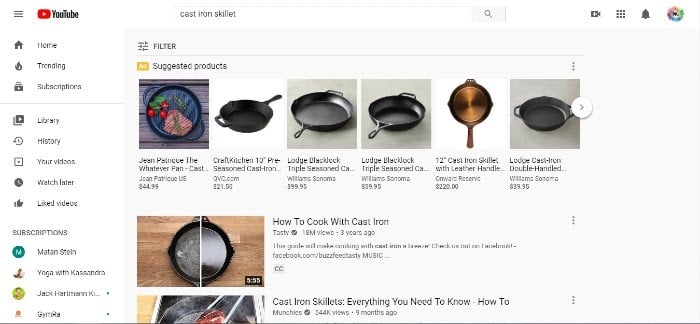
With Google Shopping Actions you have access to customer data where Amazon doesn't. You can track buying habits and trends to build closer relationships with your customers.
Now that you can upload your Amazon feed to Google Merchant Center, it's easier to run both programs on your products, potentially doubling their awareness.
Conclusion
With free Google Shopping, merchants have an incredible opportunity to grow their sales through e-commerce. By optimizing your product lists through Google Shopping Actions, you can introduce your products to users and possibly help to increase your conversions.
Consider running paid campaigns or just taking advantage of the free offers to grow your customer base and allow users to compare prices.
Have you tried Google Shopping Actions for your ecommerce store?
